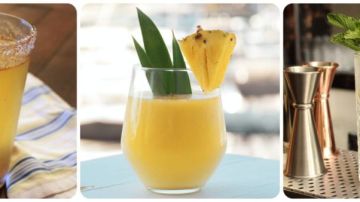9 Popular Cocktails that Originated in Latin America
In honor of Latinx Heritage Month we're looking at some of the popular cocktails that originated throughout Latin America

Photo: Wikimedia/Will Shenton Unsplash.com/YesMore Content/Tatyana Vega
In honor of Latinx Heritage Month we’re looking at some of the popular cocktails that originated throughout Latin America. Enjoy a little piece of Mexico with a classic margarita or imagine you’re on the beach in Puerto Rico with a piña colada. Whether you prefer tequila, rum, or any other spirit, there’s a traditional cocktail that you call your favorite and there’s a chance it originated in LATAM. We’ve rounded up nine of the cocktails that have origin stories in LATAM to highlight how these drinks, many of which are popular across the globe, came to be. Salud!
wp_*posts
The Macuá from Nicaragua

Originally from Nicaragua and named after a native tropical bird, the Macuá cocktail was created by Nicaraguan pediatrician Dr. Edmundo Miranda Saenza. Its ingredients are rum, simple syrup, and the juices of lemon and guava. It became the national drink of Nicaragua in 2006 after winning a competition sponsored by Flor de Caña, a Nicaraguan rum manufacturer.
wp_*posts
The Margarita from Juarez, Mexico

The margarita is undoubtedly one of the most famous and iconic drinks from Latin America. There are many claims about who invented the margarita but the most popular tale is that of Francisco “Pancho” Morales. In 1942, Morales worked at a bar named Tommy’s Place in Juarez, Mexico. A customer had ordered a Magnolia (brandy, Cointreau, an egg yolk, and Champagne) but Morales didn’t know how to make it so he improvised and made her a drink with tequila and called it a margarita. Another fun fact: this drink was named after the daisy (a margarita in English) as he claimed it was a flower like the magnolia
wp_*posts
The Mojito from Cuba

You’ve got to love the refreshing, minty taste of a mojito because it kind of tastes like you’re on vacation on the beach somewhere. The classic mojito is made with white rum, sugar, lime juice, soda water, and mint. There are several tales about the origin of the mojito but they all agree on one thing: the mojito comes from Cuba. There are also different variations of the cocktail in Latin America. For example, in Havana, many hotels add Angostura bitters or powdered sugar to cut down on the sweetness and in Mexico, some places replace the rum with tequila.
wp_*posts
The Caipirinha from Brazil

The Caipirinha is Brazil’s national cocktail which is made with cachaca (white rum made from sugar cane), sugar, and lime. It is said that this beverage was invented by farmers in the region of Piracicaba, Sao Paulo. It was originally used for high society social gatherings. The word caipirinha refers to someone from the countryside, and being that sugarcane was a strong symbol of the Brazilian culture at that time, it was only appropriate to name the drink Caipirinha.
wp_*posts
The Michelada from San Luis Potosi, Mexico

While there are many theories about the origin of the Michelada, one legend states that it was invented to cure hangovers by a bartender at Potosino Sports Club in San Luis Potosi in the 1960s. Another popular legend is that this cocktail was named in honor of Mexican general Augusto Michel who enjoyed his beer with chile and lime juice. The classic Michelada calls for a Mexican lager, salt, tomato juice, and lime juice but restaurants are now adding hot sauce, clam juice, Worcestershire sauce, soy sauce, orange juice, and fresh peppers. Get creative at home with recipes like the michelada gingembre or michelada con camarones.
wp_*posts
The Piña colada from Puerto Rico

Created by bartender Ramon “Monchito” Marrero, this cocktail has become synonymous with summer nights on the beach. The original recipe calls for rum, coconut cream, heavy cream, pineapple juice, and crushed ice. There are endless variations on this drink: you can add angostura bitters to reduce sweetness, replace pineapple fruit with kiwi, or even substituting the rum with tequila or Scotch.
wp_*posts
The Mamajuana from Dominican Republic
Photo: Instagram/@thenosygal
The Mamajuana is a spiced cocktail made with rum, red wine, honey, tree bark, and herbs. It’s very similar to sangria as it has a deep red color. Many consider the Mamajuana to be the first distilled spirit from the Americas and it is said that the Taínos, the Indigenous people of the Caribbean, originally used it as herbal tea. Commonly used herbs would be anise, cloves, cinnamon, honey, or molasses. Fun fact: these ingredients are steeped for about a year before consumption.
wp_*posts
The Aguardiente Sour from Colombia
Photo: Instagram/@mycolombianrecipes
The Aguardiente Sour was created in Colombia dating back to the 1400s, enjoyed by the Quechua who called it “Guarapo.” The Liquors and Spirits Factory of Antioquia started producing some of the highest quality spirits, at that time, including an authentic aguardiente. Aguardiente is also known as firewater and tastes like black licorice. One of the most popular ways to enjoy Aguardiente is by combining it with orange juice, sugar, egg whites, and lime juice (aka the Aguardiente Sour).
wp_*posts
The Pisco Sour from Peru
Video: Instagram/@h4ppysour
The Pisco Sour’s name from from it’s liquor base (pisco) and the sour citrus juice that is added to it. A Peruvian Pisco Sour has pisco, fresh lemon juice, simple syrup, an egg white, Angostura bitters, and ice. Many cocktail experts believe that this drink was created in the 1920s in Lima, Peru by Victor Vaughen Morris. Peru even celebrates the cocktail on the first Saturday of February every year!

















